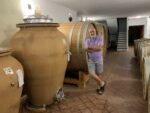Everyone in the wine world has heard about phylloxera, an aphid that in the XIX century came from North America and devastated most of the rest of the world’s vineyards. This malicious pest is the reason why nowadays most of the vines on the globe are grafted to the American rootstock, resistant to the plague. Though, there are some places where European vines can still survive on their own roots: the volcanic soils of Santorini and Lanzarote, the sandy terrains of Colares near Lisbon, some parts of Australia, and Chile. Daktulosphaira vitifoliae, as scientists call the aphid, can’t survive in the sandy soils as it can hardly propagate. We also can find some rare examples of pre-phylloxera vines everywhere in the world, like “Vieilles Vignes Françaises” by Bollinger in Champagne or “La Vigna di Don Peppino” by Tenuta delle Terre Nere on Etna. These wines are rare and highly cherished.
IN THE SEARCH FOR THE ORIGINAL TASTE
Today there are more and more courageous (or reckless?) producers who start establishing new vineyards on their own roots, like, as an example, in 2015 Château Dauzac in Margaux planted a parcel of less than one hectare with ungrafted vines of Cabernet Sauvignon. The plot was not chosen randomly. Electrical resistivity tests showed a thick layer of gravel on the plateau which was not planted before and thus was not infected by the aphid. The cuttings to be planted were obtained by a rigorous massale selection of the best Cabernet Sauvignon vines of the property. The parcel is managed with great care and precaution. Laurent Fortin, the General Manager of the Château, explains that all the machinery and tools are disinfected before entering the plot which is only accessible to one person, the vineyard manager.
The vines are managed biodynamically and pruned very late to delay the bud break and avoid the possible damage of the spring frost to the new buds. The vintners of Château Dauzac noticed that the ungrafted vines develop in a particular manner. For the first two years, they grow the root systems and invest the energy in their feeder roots, so there are neither leaves nor fruit. In the third year only they start producing a tiny amount of grapes. In general, they give smaller andmore compact bunches but the juice is dense and more concentrated. The yield is low, around 20 hl/ha which is twice less than what the Chateau harvests from the grafted vines.
On October 13, 2021, the parcel saw the first harvest. The wine was made in clay amphoras (dolias) produced in the French Basque country to avoid any influence of oak on the wine and preserve the original taste of the unique grapes but also to provide an exchange with the air through the pores of the vessel. The 400 exclusive bottles will be released in 2023. The imposing flask is engraved with two dates: 1867 – the year when phylloxera arrived in Médoc and 2021 –the vintage of the first harvest. There are also the exact geographical coordinates of the parcel that link the wine to its birthplace.
THE ASSOCIATION
Château Dauzac is a relatively recent addition to the “franc de pied” cohort of prominent producers. Thibault Liger-Belair owns a more than hundred-year-old, pre-phylloxera parcel in Beaujolais and Alexandre Chartogne produces “Les Barres”, a 100% ungrafted Pinot Meunier champagne. Even in Bordeaux, there are outstanding examples, like the Right-bank
Château La Vieille Chapelle which owns a 0,3 ha parcel with old, ungrafted vines of Merlot, Bouchalès, Castet, and other forgotten varieties. In Graves, passionate and energetic Loic Pasquer, the ”enfant terrible” of Bordeaux, produces his ”Liber Pater”, one of the most expensive wines in the world. Pasquet is the locomotive of the “Francs de Pied” association uniting producers from Italy, Greece, Germany, Austria, Spain, Portugal, and Switzerland but also the French grands like Château Dauzac. According to Laurent Fortin, the main objective of the group is to share knowledge and experience as growers need to rediscover the lost skills of working with ungrafted vines. The association also declared that it will work for the recognition of this type of viticulture in the European legislation and apply for the UNESCO classification.
A CAHNCE FOR THE FUTUR OR A NEW UTOPIA
Not everyone in the wine world is enthusiastic about the ungrafted vines. Professor Attilio Scienza, one of the prominent Italian scientists, is very skeptical about the idea. He believes that planting vines on their own roots is dangerous and irresponsible, as sooner or later even the untouched lands will surrender to the aphids. It is also not sustainable economically because re-planting will be necessary within a short period. In some countries, like Germany and Georgia, this kind of viticulture is not even authorized.
Climate change is not helping either. With the rise of temperatures and warmer winters, all the pest change their behavior, and some become more aggressive, so more research should be planned to predict the propagation of the plague.
Others are convinced that planting new ungrafted vineyards from massale selection of the old pre-phylloxera plots might be a solution for the recent challenges. These ancient vines, just by reaching this age, showed their resistance and great adaptability. Using these cuttings will help to increase the genetic diversity and improve the overall immunity of plantations against pests and diseases.
No doubt, the debates if there is a real taste difference between the wines from grafted and ungrafted vines are interesting, but practically we need more scientific research and practical observations to understand if the ”franc de pied” can be an option for the future and not just a rare curiosity.
Château Dauzac
1 Av. Georges Johnston
33460 Labarde – France www.chateaudauzac.com




